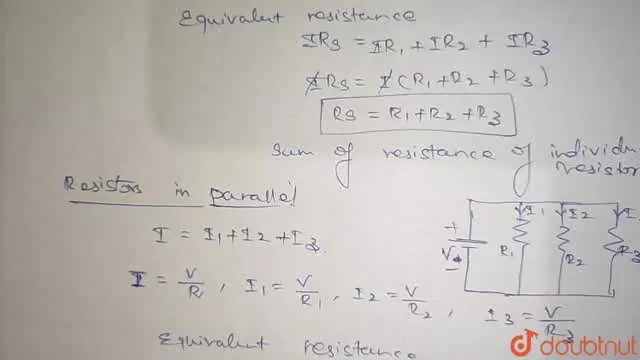Explain the equivalent resistance of a series and parallel resistor network. Solution in Tamil
(i) When two or more resistor are connected end to end, they are said to be in series. The resistors could be simple resistors or bulbs or heating elements of other devices. Figure (a) shows three resistors, R1,R2andR3 connected in series.
(ii) The amount of charge passing through resistor R1 must also pass through resistors R2

and R3 since the charge cannot accumulate anywhere in the circuit. Due to this reason, the current I passing through all the three resistors is the same.
(iii) Accordig to Ohm's law, if same current pass through different resistors of different values, then the potential difference across each resistor must be different. Let V1,V2andV3 be the potential difference (voltage)across each of the resistors R1,R2andR3 respectively, then we can write v1=IR1,V2=IR2andV3=IR3. But the total voltage V is equal to the sum of voltages across each resistor.
V=V1+V2+V3=IR1+IR3 ......(1)
V=I(R1+R2+R3)
V=I.RS ....(3)
where RS is the equivalent resistance,
RS=R1+R2+R3
(iv) When several resistances are connected in series, the total or equivalent resistance is the sum of the individual resistances as shown in the figure (b).
Note : The value of equivalent resistance in sereis connection will be greater than each individual resistance.
Resistors in parallel :
(i) Resistors are in parallel when they are connected across the same potential difference as shown in figure (a).
(ii) In this case, the total current I that leave the battery split into three separate paths. Let I1,I2andI3 be the current through the resistors R1,R2andR3 respectively. Due to the conservation of charge, total current in the circuit I is equal to sum of the currents through each of the three resistors.
I=I1+I2+I3 ....(3)
(iii) Since the voltage across each resistor is the same, applying Ohm's law to each resistor we have
I1=VR1,I2=VR2,I3VR3 .....(4)
Substituting these values in equation (3), we get
I=VR1+VR2+VR3=V[1R1+1R2+1R3]
I=VRP
1RP=1R1+1R2+1R3 ....(4)

(iv) Here RP is the equivalent resistance of the parallel combination of the resistors. Thus, when a number of resistors are connected in parallel, the sum of the reciprocal of the values of the values of resistance of the individual resistor is equal to the reciprocal of the effective resistance of the combination as shown in the Figure (b).
Note : The value of equivalent resistance in parallel connection will be lesser than each individual resistance.
Similar Questions
Find the equivalent resistance of the two resistors connected in parallel series.
02:58View SolutionThe equivalent resistance of network of three 2Ω resistors can not be
06:22View SolutionThe equivalent resistance of network of three 4Omega resistors can not be
07:27View SolutionExplain series connection of resistors. Derive equation of equivalent resistance (RS).
04:49View SolutionThe equivalent resistance of a series combination of two resistors is '9 Omega' and the equivalent resistance of a parallel combination of the same two resistors is 2Ω. Find the resistances of the resistors.
04:05View Solutionदिए गए चित्र में प्रतिरोधों के नेटवर्क का समतुल्य प्रतिरोध होगा
 01:51View Solution
01:51View SolutionTwo resistors are connected (a) in series (b) in parallel. The equivalent resistance in the two cases are 9 ohm and respectors. Then the resistances of the component resistors are
View SolutionThe equivalent resistance of n identical resistors connected in parallel is x. If the resistors are connected in series, the equivalent resistance would be
View Solution


